Sustainable sweet variety of honeysuckle "Cinderella"
Variety edible honeysuckle Cinderella is popular among gardeners due to its many advantages and ease of care. But along with this, there are a number of nuances that must be taken into account when planting and growing crops. We will talk about the features of cultivating this variety, its pros and cons.
Description of the honeysuckle variety Cinderella
Cinderella is a variety of edible honeysuckle bred by breeders from Siberia. Its fruits are suitable for fresh consumption, drying, freezing and canning. They have a rich chemical composition and are used in folk medicine for the prevention and treatment of various diseases.
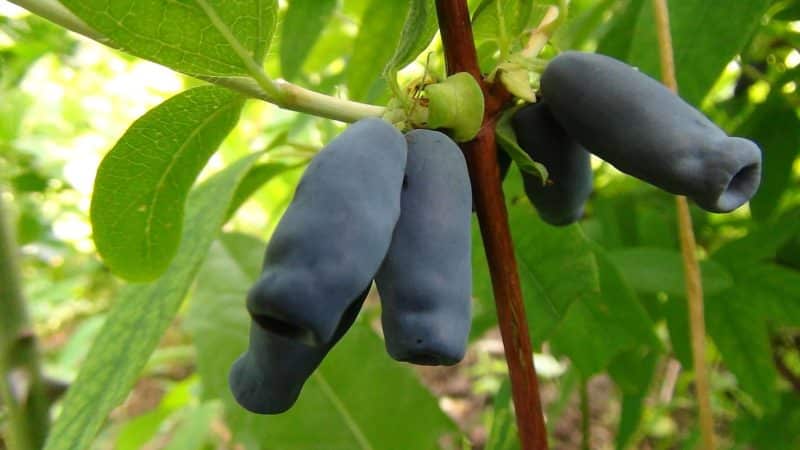
Breeding history
The variety was bred in 1974 by scientists from the Siberian Research Institute of Horticulture named after. M. A. Lisavenko as a result of free pollination of Kamchatka honeysuckle species No. 8. Originator: Federal Altai Scientific Center for Agrobiotechnologies.
State testing of the variety began in 1982, but it was included in the State Register of Russia only in 1991.
Chemical composition and beneficial properties
100 g of berries contain:
- ascorbic acid – 20 mg;
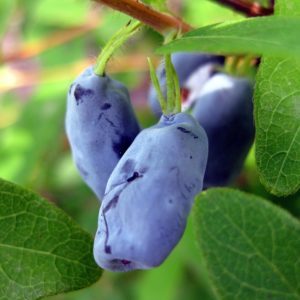
- vitamin P – 600 mg;
- sugar – 8.4-8.7%;
- pectin – 1.12%;
- calcium – 19 mg;
- iodine – 1 mcg;
- potassium – 70 mg;
- phosphorus – 35 mg;
- sodium – 35 mg;
- iron – 0.8 mg;
- silicon – 10 mg;
- manganese – 0.09 mg.
Low-calorie honeysuckle fruits have anti-inflammatory, antibacterial, antifungal, bile and diuretic properties.The berries are used as an antioxidant and antiviral agent, for diseases of the stomach and intestines, and to strengthen vision.
Honeysuckle It reduces temperature well, relieves coughing attacks, stabilizes blood pressure, and has a beneficial effect on the functioning of the liver, gall bladder and gastrointestinal tract. It helps strengthen the immune system, eliminate toxins and heavy metal salts and prevent the formation of cancer cells.
Reference. The chemical composition of berries changes depending on weather conditions.
Features of application
Honeysuckle berries are consumed fresh, dried and added to tea, frozen, and used to make preserves, compotes and jams.
Ripening period, yield and fruiting
Cinderella is an early ripening honeysuckle variety. Depending on the region growing The harvest is harvested in one of the ten days of June.
Fruiting is heterogeneous; the bushes begin to bear fruit for the first time 3 years after planting. The average yield is 10.5 c/ha, the maximum is 21 c/ha.
Resistance to diseases and pests
The variety is resistant to fungal and viral diseases and pests, but in some cases it is affected by:
- powdery mildew;
- moniliosis;
- cercospora blight
Resistance to cold and drought
Honeysuckle Cinderella is frost-resistant, tolerates air temperatures down to -32°C and does not require winter shelter. It does not tolerate drought well and requires regular watering in hot weather.
Characteristics, description of appearance, taste
The honeysuckle variety Cinderella is represented by deciduous low-growing shrubs, reaching a height of no more than 50-70 cm with a tree-like, branched root system. The crown is dense, compact and medium spreading.
Shoots are straight or curved, medium thickness, without pubescence, green. The leaves are large, oval-elongated, slightly concave, colored light green. In May, during flowering, large white flowers appear on the bushes.
The blue-violet berries are covered with a bluish waxy coating and have an oval-elongated, elongated or spindle-shaped shape. Their length reaches 1.7 cm, weight ranges from 1 to 1.4 g.
The taste is soft, harmonious, sweet with slight sourness and a bright strawberry aroma.
Growing regions and climate requirements
Due to its high frost resistance, Cinderella was initially zoned in the Ural region, Eastern and Western Siberia. The variety does not make any special demands on the climate, so it is now grown in all regions of Russia.
Advantages and disadvantages of the variety
Pros of Honeysuckle Cinderella:
- frost resistance;
- high yield with proper care;
- disease resistance;
- early maturation;
- excellent taste;
- decorative type of shrub.
Disadvantages of the variety:
- need for pollinating varieties;
- tendency to shed berries;
- uneven ripening of fruits;
- difficulties with harvesting when using technology.
Difference from other varieties and hybrids
A comparison of Cinderella with other honeysuckle varieties is presented in the table.
| Variety/hybrid | Ripening period | Average weight of berries, g | Taste | Berries shape | Productivity, c/ha |
|---|---|---|---|---|---|
| Cinderella | Early | 1-1,4 | Sweet with sourness | Oval-elongated, elongated or fusiform | 10,5 |
| Ivushka | Average | 0,75 | Sweet and sour with bitterness | Fusiform | 50 |
| Kamchadalka | Early | 0,8 | Sweet and sour | Extended | 31 |
| The Giant's Daughter | Mid-late | 1,8-2,5 | Sweet and sour | Elongated teardrop-shaped | 69,4 |
| Krasnoyarochka | Average | 0,62 | Sweet and sour | Capsicum | 33,2 |
Agricultural technology
In order for the bushes to grow, develop and bear fruit well, it is necessary to comply with the agrotechnical requirements that the plant imposes.
Priming
The variety prefers nutritious, light, moisture-absorbing soil with good breathability and a neutral acidity level (pH 6.5-7). The best option is loam and sandstone.
Choosing a place in the garden, preparing holes and seedlings
The place for planting honeysuckle should be easily accessible for watering and other care and well lit - under the influence of sunlight, fruit buds are formed, which increases productivity.
The soil in the selected area is dug up in advance and cleared of plant debris. Lime is added to acidic soil during digging, and coarse sand is added to heavy soil.
Holes are dug 0.4 × 0.4 × 0.4 m in size, the top layer of soil is mixed with compost or humus and wood ash, watered and poured into the planting hole.
When choosing planting material, preference is given to 2-3-year-old seedlings in pots rather than with an open root system. The leaf plates on them should be glossy, shiny, without signs of disease or pest damage.
Dates, scheme and rules of planting
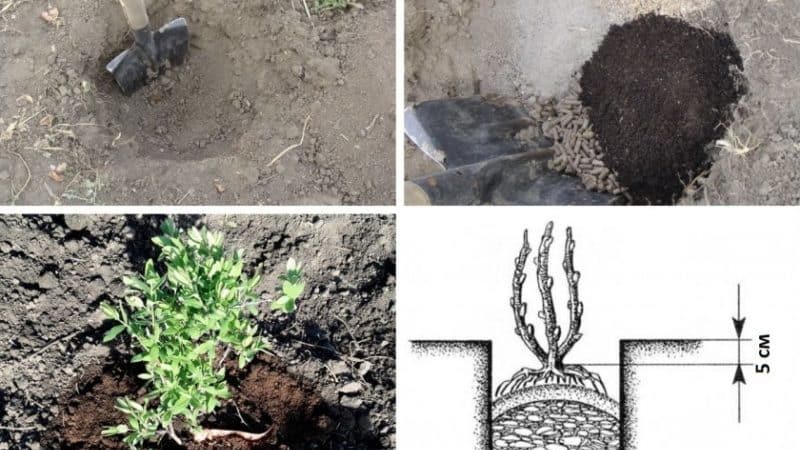
Honeysuckle seedlings are planted in the fall after the end of the growing season (late September - early October) or in the spring after the snow melts and before the start of sap flow (in March).
Planting pattern:
- Remove the seedling from the container in which it grew, along with a lump of earth.
- Gently straighten the roots and soak them for 20-30 minutes. in a solution of a growth stimulator (“Kornevin”, “Epin”).
- Make a depression in the center of the planting hole.
- Place the seedling in it without deepening the root collar.
- Sprinkle the plant with a nutrient substrate and tamp it down.
- Water the soil generously with warm water.
Cinderella bushes are planted at a distance of 1.5-2 m from each other.
Features of cultivation
For planting, use seedlings 30-40 cm high with 2-3 branches, buds on the branches and healthy roots. At the same time as Cinderella is planted, pollinating varieties are planted nearby, otherwise there will be no harvest.
The bushes are watered as the top layer of soil dries. On average, the soil is moistened once a week, pouring 10 liters of water under each bush.
Reference. After each watering, the soil is loosened - this improves the access of moisture and oxygen to the roots and avoids the formation of a crust on the surface of the soil.
For 2 years, the plants have enough nutrients that were added to the ground when planting the seedlings. From the age of 3, fertilizing is done according to the following scheme:
- before flowering and after harvesting - a solution of chicken manure;
- July-August - ash solution.
Bushes are pruned annually. For the first time, the bushes are pruned immediately after planting, removing all weak and damaged branches and leaving up to 5 strong shoots, which are shortened by a third. After this, before or after the growing season, sanitary pruning is carried out, removing dry, frozen and broken branches. When shrubs reach the age of 7 years, their fertility decreases, so rejuvenating pruning is carried out in the fall, which consists of removing all old branches.
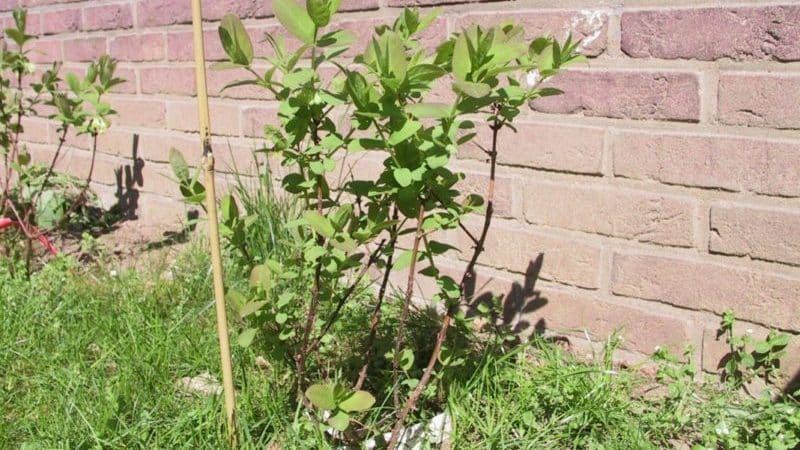
Pollinators
Cinderella is a self-sterile variety. To obtain a harvest of berries, pollinating varieties are planted nearby. The most suitable ones are presented in the table.
| Variety | Fruit set level, % |
|---|---|
| Azure | 76 |
| Gerda | 55 |
| Fiery | 36 |
| Kamchadalka, Tomichka, Amphora | 25 |
Berel, Salyut and Blue Spindle varieties are not used for pollination.
Disease and pest control
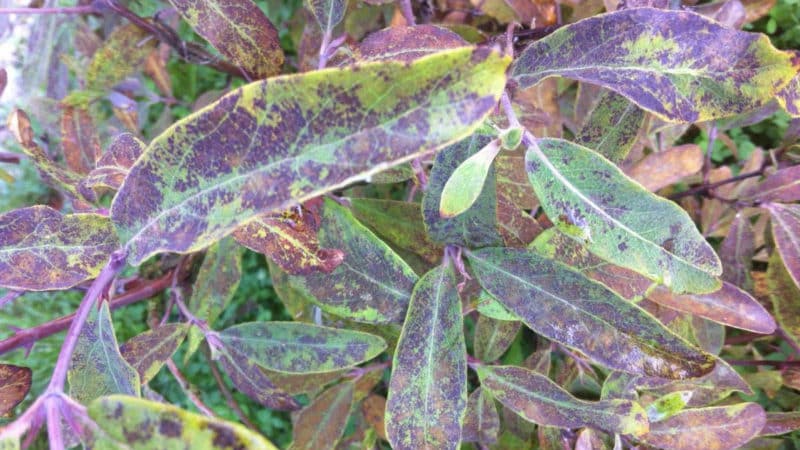
Diseases that affect honeysuckle:
- Powdery mildew. To combat the disease, use a solution of copper sulfate, tobacco dust and soap.
- Moniliosis. In the initial stage of the disease, infected branches are pruned, and the bushes are treated with copper-containing preparations (for example, “HOM”). To prevent moniliosis, use “Fitolavin”.
- Cercospora blight. The bushes are thinned out, infected leaves are removed, and for prevention in the fall or early spring, they are treated with Fitolavin.
To prevent disease, in early spring, bushes are treated with Bordeaux mixture, dry and damaged branches are regularly removed from the crown, and fallen leaves are removed.
Among the insect pests that pose a danger to honeysuckle are mites, aphids, nematodes, glass beetles and moths. To combat them, the affected parts of the plants are cut off and the bushes are treated with insecticides (Fitoverm, Aktara, Karbofos).
This is interesting:
How to treat beet cercospora and prevent the occurrence of this disease.
The most effective folk remedies for powdery mildew on currants.
Why does powdery mildew appear on cucumbers and why is it dangerous?
Difficulties in growing
Cultivating honeysuckle Cinderella poses some difficulties:
- the plant withers despite regular watering - the bushes are probably infected with moniliosis;
- dark green spots appear on the leaves, which over time acquire a brown tint with a dark outline - a sign of cercospora;
- low yield - the bushes do not have enough light.
Harvest and storage
After all the work put into growing honeysuckle, it is important to harvest the ripe berries on time and correctly.
How and when to collect
The berries are harvested in the first half of June, plucked from the bushes by hand. Due to uneven ripening, the berries are harvested in 2 stages.At the same time, they try to collect 80% of the fruits in the first go, since they are prone to shedding.
Reference. When picking berries, place a cloth under the bush - this helps to collect the crumbling fruits.
Storage Features
Fresh berries are stored for 2-3 days in the refrigerator in the vegetable compartment.
Preparing for winter
The variety is frost-resistant, so the bushes are not covered for the winter. At the same time, there is a risk of plant death in case of sudden temperature changes. To avoid this, the ground is mulched with sawdust or covered with spruce branches.
Reproduction
Green cuttings are the most effective way to propagate honeysuckle, in which about half of the planting material takes root. Procedure:
- Separate from the mother plant a branch of annual growth 20-40 cm long with a piece of cambium.
- Place the cuttings in a solution of a growth stimulator (Heteroauxin, Kornevin) for 12-16 hours.
- Plant it in a garden bed in a mixture of peat and perlite at an angle of 45°.
Another method of propagation is air layering. To do this, select a suitable side shoot, tilt it, fix it and sprinkle it with earth. With regular watering, roots and sprouts form in the internodes. In the spring, the cuttings are separated from the mother bush and transplanted to a prepared area.
Reference. The seed propagation method is rarely used, since it does not guarantee the preservation of varietal characteristics.
Tips and reviews from experienced gardeners about the variety
Experienced gardeners recommend:
- use ash infusion to spray bushes - it serves to prevent the development of diseases and insect attacks;
- When preparing the site, pour boiling water and potassium permanganate onto the soil - this will help get rid of rodents and kill pathogenic flora.
Gardeners speak positively about the Cinderella variety:
Alexey, Nizhny Novgorod: “My father began growing edible honeysuckle on the property. He started with Cinderella, then tried several more varieties, but in the end he liked Cinderella more, although other varieties produced larger fruits. The fact is that there are always more berries on the Cinderella bushes and they taste wonderful - very sweet with a slight sourness and strawberry aroma.”
Maria, Perm: “I love the Cinderella variety for its productivity and unpretentiousness. There are not very many berries, because there is only one pollinating bush nearby, but we have enough. And we grow this honeysuckle not so much for its fruits, but as a hedge - the bushes are very beautiful, they decorate the area.”
Conclusion
Despite the presence of serious disadvantages, such as the need for pollinators, uneven ripening of berries and a tendency to shed them, Cinderella honeysuckle is popular among gardeners. An unpretentious and disease-resistant variety suitable for cultivation in the Urals and Siberia. Its fruits are useful, and the bushes have a decorative appearance.